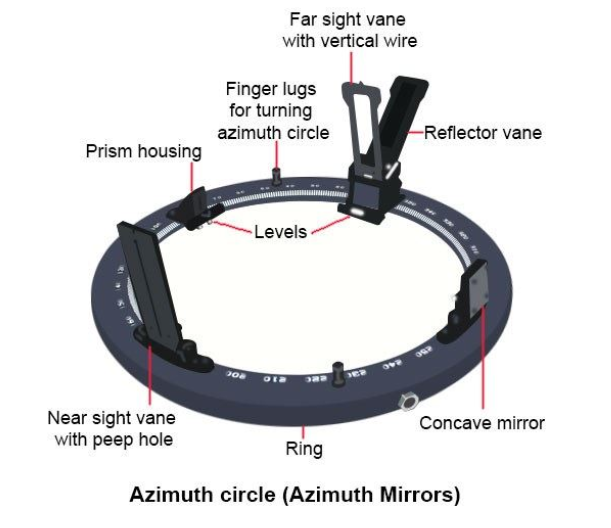Azimuth Circle: A Navigator’s Essential Tool for Precise Measurements
For centuries, the magnetic compass has guided explorers and navigators across land and sea. But its accuracy can be enhanced with a crucial accessory: the azimuth circle. This seemingly simple device unlocks a wealth of information, making precise measurements and navigation a breeze.
What is an Azimuth Circle?
Imagine a circular ring with a graduated scale, typically in degrees, mounted on top of a magnetic compass. This is the azimuth circle. It rotates freely, allowing you to sight an object and measure its azimuth, which is the horizontal angle between true north and the object’s direction.

Benefits of using an Azimuth Circle:
- Enhanced Accuracy: Compared to simply reading the compass card, the azimuth circle provides a much more precise measurement due to its finer graduations.
- Versatility: It’s not just for sighting landmasses. You can use it to measure the azimuth of celestial bodies like the sun or stars, aiding in navigation and timekeeping.
- Multiple Applications: Azimuth circles are valuable tools in various fields, including:
- Navigation: Marine, land, and air navigation all rely on accurate azimuth measurements.
- Surveying: Measuring angles between landmarks and calculating distances.
- Military: Target acquisition, artillery fire control, and troop movement.
- Astronomy: Studying celestial bodies and their movements.
How to Use an Azimuth Circle:
- Mount it securely on your compass. Ensure it rotates freely and aligns with true north.
- Sight the object of interest through the provided sighting vane or alidade.
- Rotate the azimuth circle until the line of sight aligns with the object.
- Read the corresponding value on the graduated scale. This is the object’s azimuth in degrees.
Additional Features:
- Some azimuth circles have built-in levels for ensuring horizontal alignment.
- Advanced models may include mirrors for sun observations and internal scales for calculating distances.
- Materials vary, with lightweight plastics or sturdy metals depending on the intended use.
Choosing the Right Azimuth Circle:
The best choice depends on your specific needs and budget. Consider:
- Accuracy: Higher precision models have finer graduations for more accurate readings.
- Durability: For demanding environments, choose a sturdy metal construction.
- Features: Decide if you need additional features like levels or mirrors.
- Compatibility: Ensure it fits your specific compass model.
In Conclusion:
The azimuth circle is a powerful tool that elevates the capabilities of any magnetic compass. Its ability to measure precise angles makes it invaluable for navigation, surveying, and various other applications. Whether you’re a seasoned navigator or just starting your exploration, consider adding this essential tool to your kit for accurate and confident direction finding.


Latest Products
YDK Technologies MKN020 Gyro compass connection box
AED 3,960.0Original price was: AED 3,960.0.AED 2,850.0Current price is: AED 2,850.0.Onwa KM-8X 5-in-1 Marine Bundle Set Radome – GPS, Chartplotter, EchoSounder, AIS, Radar
8-inch GPS Chart Plotter with AIS and Radar
Onwa KM-8A (BUNDLE) 8-inch Color TFT LCD GPS Chart Plotter with Class B+ AIS Transponder MFD [BUNDLE]